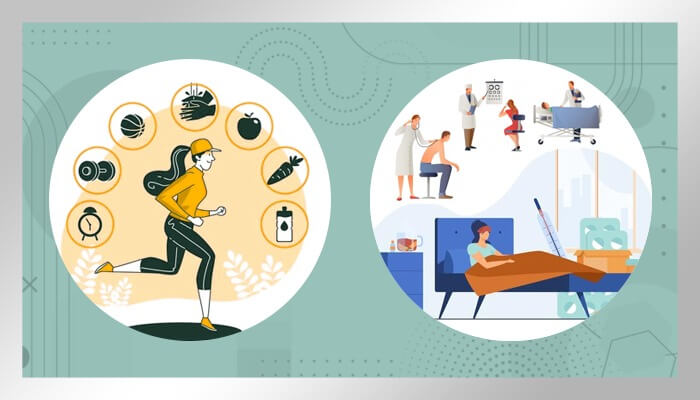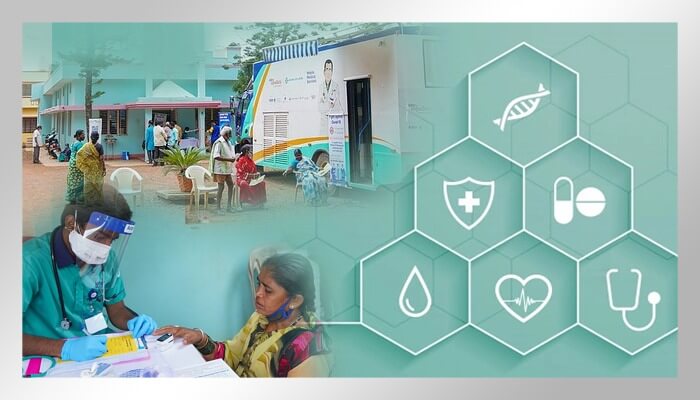There’s good news in the pipeline for India’s rural healthcare system. A roundtable on ‘Technology to address the last mile in Healthcare’, hosted by IIITH’s Raj Reddy Centre for Technology & Society, grappled with challenges in the rural Medicare system and emerged with innovative technology-based solutions.
The Great pandemic of 2020 turned the world on its head. Overnight, the medical world had to come together to fight an unknown phantom and deliver efficient medicare, in real time, to the remotest parts of the country.
A roundtable on ‘Technology to address the last mile in Healthcare’, hosted by IIITH’s Raj Reddy Centre for Technology & Society, deliberated on 3 fundamental areas; challenges/ gaps in rural healthcare services, ideas on delivering cost-effective healthcare models to the rural doorstep and technologies-based (AI, devices, ++) solutions that can provide quality healthcare at scale. Intelligent technology can help bridge the rural-urban chasm and deliver compassionate care with data-driven interventions.
Deconstructing India’s rural Medicare system
“Grassroot healthcare, especially in rural settings is a hard problem” points out Varma Konala, roundtable facilitator and CEO of IIITH’s INAI center. “Even as governments continue to invest in PHCs and other structures, actual on-ground availability of care is very minimal.”
The panel included grassroot NGOs- Dr. Chinnababu Sunkavalli – Co-founder of Grace Cancer Foundation, Manoj Gopalkrishna, CEO, CARE India and Mayur Patnala – Founder of Nirmaan Organisation, medical practitioners Dr. Evita Fernandez and Dr. Radha Reddy and academics Prof. Dr. Shailaja Tetali and IIITH Prof. Bapi Raju. The corporate sector had an interesting mix of thinkers like Ramanathan Sethuraman and Udaya Dintyala, Prof. Sarang Deo – Executive Director, Max Institute of Healthcare Management, Manish Ranjan – CEO of Nano Health, KV Rao – MD, Subhaarogya Healthcare Services, med-tech startup Founder of Vaccine on wheels – Jignesh Patel, rural and policy/impact investors – Harish Iyer, Senior Advisor for the Bill & Melinda Gates Foundation and Lakshmi Sethuraman of Sattva Consulting.
Finding the gaps in rural healthcare
Vijayawada’s PHCs are installed with diagnostic equipment that generate reports of 14 tests at a time, but who will man these machines? Therein lies the crux of the problem.
Government health schemes like the Anemia Mukt Bharat, auxiliary nurse midwives, Janani Suraksha Yojana or the Pradhan Mantri Surakshit Matritva Abhiyan have great potential, but are falling short of projections. The ground reality is that they suffer from severe resource and capability constraints and lack the necessary monitoring mechanisms. Connecting rural frontline workers to effective channels for skilling as well as continuous education on diseases, diagnosis and treatment is the challenge. Can we look at systematic approaches to introduce the right technology to empower the frontline workers to get to the right decisions?
Missing links in last mile delivery leads to incomplete services
Today, Last mile logistics to ensure availability of medical supplies & uninterrupted treatment protocols for chronic illness is a key area of concern. The whole journey of the patient should be treated as a system. But, in many cases, post-diagnosis, there are factors fueling failure, like the unavailability of prescription/medication and lack of referral facilities. Data systems should be in place, to document every consultation, with health & operational information, follow up care or referrals, especially for patients who require long term medical treatment. Datasets that contain evidence of the government programs will help to steer policy in the right direction.
Training in emergency care to reduce fatalities and disabilities
With only 1% of the world’s vehicles, India has a skewed statistic of 11% of road fatalities or permanent disability. Much of this is avoidable with timely treatment, for which continuous training of health workers becomes a crucial component. Understaffed, overworked and undertrained Asha workers and poor competency of managers who train them was identified as a fundamental problem. Lack of sensitivity in handling patients and mental healthcare were other areas of concern. For instance, in public hospitals, the manner in which mothers are treated during a traumatic birth experience, leaves emotional scars and prevents them from returning to the public healthcare system.
Can we change our attitude from Sick-care to Health-care?
“The village is the cell of the national body and the cell-life must be healthy and developed for the national body to be healthy and developed” – Sri Aurobindo
A crucial point that emerged was the need to re-jig our perspective of rural healthcare and focus on primary prevention and create awareness about lifestyle modifications for healthcare. For secondary prevention, early detection and diagnosis is possible with structured screening programs, facilitated by mobile health units for cancer, diabetes and hypertension; the first step towards a healthier rural India.
Incentivizing health workers will motivate them to continuously supervise long-term treatment as well as undertake regular screening for non-communicable diseases. This can lead to a self-sustaining ecosystem and has scope to generate continuous longitudinal data, to create healthier communities.

Public-private partnerships and low-cost local solutions
Private corporations enjoy a certain amount of trust that is different from the public health system. The private sector is making immense efforts to reach the villages to provide quality care but struggles with funding support. On the other hand, the government sector struggles with quality training and service delivery. The way forward would be in government-corporate collaboration where public healthcare programs can be optimized with private sector training models for ANMs, GNMs, paramedics and other frontline staff.
It’s a well-known fact that costly medical equipment donated by global benefactors tend to die an ignoble death in some remote warehouse because they are not designed for erratic power and unskilled operators. Low-cost local solutions like mobile medical services have become the pathway to extend Medicare to the unreachable today. NGOs and private organizations like Nirmaan, Grace Cancer Foundation, Nano Health, Vaccine on Wheels and Subhaarogya are using mobile units to make basic healthcare facilities accessible to all. Some important drivers to leapfrog that last mile in rural healthcare are Technology that can build multiplex diagnostics devices like ECG, CT scans at minimal cost, designing of simple training modules and scientific utilization of locally available resources.
AI (NLP, ML) based solution models to offset lack of training
Getting doctors to the rural area is challenging. Theoretically, while telemedicine is available, they have not managed to make inroads into the rural sector, due to the hectic work hours of the medical fraternity. Thus, building vernacular language integrated models through NLP can increase the capacity of acceptance and participation of the rural Medicare system. Artificial Intelligence can help build systems through ML. For instance, a doctor can dictate a prescription from a remote location, that is relayed by voice interface to the nearest physician’s records and medication is delivered to the villager’s doorstep.
AI & other technologies can be efficiently used to enhance the productivity of the existing resources. Technology can help develop medical devices to seamlessly transmit data to an app or a smartphone. From these longitudinal data points, one could look for early disease signals/detection in normal individuals, or monitor disease progression in chronic patients, from a central location.
Datasets as a prescription for the malaise
Statistics indicate that 97% of all publicly available genomic datasets is western data, that is of no relevance to the Indian context. Data on rural health systems is collated from across the spectrum; self-data collection by chronic patients provided with monitoring devices, Asha workers who undertake door to door testing, Mobile medical services that provide a range of preventive/curative services or PHC- based data collection.
The discussion looked at curated solutions on connecting rural patients through electronic records, initiating a continuous dialogue on positive and negative behavior and creating pathways for a referral system for serious health conditions. “This kind of dataset can give insight from a granular level to a broader population level to facilitate public health policies and clinical to administrative decision making”.

Drawing up the blueprint for compassionate rural healthcare
The Raj Reddy Center will look at secure collaborations with on-ground working entities to engage research-based solutions to bridge the gap in rural health care. Strategic partnerships will look at transformational services, creating non-invasive solutions for upgrading PHCs, skilling frontline personnel, mobile medical services, vision based solutions and last mile logistics. The confluence of ideas from the medical sciences, domain project teams, development specialists, product designers and engineering will look at building scalable models, based on geography and demography, to establish healthier rural communities.



Next post